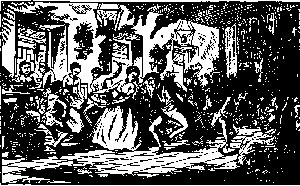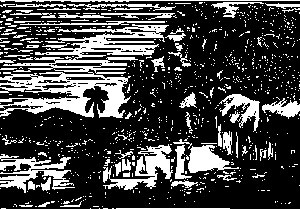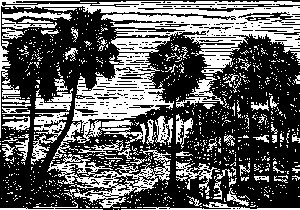John Capper: A life in old Ceylon

Dancing the Caffreina (Illustrations from Capper’s ‘Old Ceylon’)
John Capper (1814-1898) is one of those 19th-century British colonists who contributed something worthwhile to the island – in his case mainly to the development of journalism in English, particularly editorship, and early newspaper and periodical production. In addition he was an author of factual and historical publications of value, not only of Ceylon, but India and Australia too. And as far as fiction is concerned he could have influenced Charles Dickens to create two characters from Ceylon in his final but unfinished novel.
Capper began his journalistic career by helping edit The Mining and Steam Navigation Gazette before he sailed to Ceylon in 1837. He was employed at Acland & Boyd, a leading agency house primarily involved in the coffee industry, though he was manager of the firm’s cinnamon properties. In 1839 he became a more permanent member of the firm by marrying co-founder Acland’s daughter, Anna Amelia. By 1846 he was a junior partner in charge of the entire export business.
He was also a pioneer coffee planter, a career he encapsulated in writing, the publication of which will be explained later. DM Forrest states in One Hundred Years of Ceylon Tea 1867-1967 (1967): “The great leit motif of the coffee planting era was what John Capper calls the ‘merry chime’ of axes felling the glorious forests.”
Capper claims it was “a pretty and novel sight” to experience the felling. His lack of environmental sensitivity is understandable; nevertheless the description disturbs ecologically-attuned citizens. He explains how dozens of trees were axed almost to the point of felling, then “all being ready, the manager sounded the conch sharply, two score voices raised a shout, forty axes gleamed high in the air, then sank into as many trees, which groaned heavily, waved their huge branches to and fro like drowning giants, then toppled and fell with a stunning crash on the trees below. These, having been cut previously, offered no resistance, but followed the example of their upper neighbours and fell booming on those beneath.”
In the mid-19th century, journalistic activity in literary and scholarly subjects rapidly advanced. Capper initiated and edited The Ceylon Magazine, a periodical for Orientalists and antiquarians, from 1840 to ‘42. Though short-lived, it demonstrated the need for such a forum, satisfied in 1845 when Capper and 33 others formed the Ceylon Branch of the Royal Asiatic Society, successor to the Colombo Literary Society. Appointed treasurer and librarian, Capper was in excellent company.
One of three vice-patrons was James Emerson Tennent, who neglected his colonial duties to write one of the best-known accounts of the island, Ceylon (1859). And the secretary was William Knighton, author of the lesser-known Forest Life in Ceylon (1854), described by DCRA Goonetilleke in Encyclopedia of Post-Colonial Literatures in English (2004) as “the only creative work of value” in the 19th century.
The coffee crash of 1847 resulted in Acland & Boyd suspending business: Forrest (1967) informs readers that it launched Capper “on a series of careers in which the management of companies in Colombo and Calcutta alternated with journalism in Colombo and London”.
In fact he returned to London in 1848 for a decade, and began by contributing articles on Ceylon life to the early volumes of Charles Dickens’ popular monthly Household Words, published between 1850 and 1859. Only the name of Dickens, the editor, appeared; articles were unsigned. Capper must have known Dickens for a few years, and been questioned regarding faraway Ceylon and its colonists. Thus it is possible he unwittingly influenced the author in the decision to make Neville and Helena Landless, British twins born in Ceylon, principal characters in his last and alas unfinished novel, the experimental Mystery of Edwin Drood (1870). Helena was a formidable female character for Victorian times: “Each time she dressed as a boy, and showed the daring of a man.” (See my “Ceylon Connection with Dickens’ Unfinished Tale”, the Sunday Times, October 11 and 18, 1998.) There is a more popular theory, however. Dickens knew the Victorian actor William Charles Macready – indeed he was an intimate friend of the family – and Macready’s son from his first wife, also called William, served in the Ceylon Civil Service as an assistant government agent and a district judge. He was a linguist and published in 1865 a translation of Sri Rahula’s poem “Sela Lihini Sandese: the Sela’s Message, with Notes and a Glossary, for the use of Students”. He died in Puttalam in 1871 aged 39. There have been countless efforts to provide an ending to the novel – in every conceivable form, including audience-interactive theatre – from soon after Dickens’ death to the present day, listed (albeit now incomplete) in my 1998 article. The Mystery of Edwin Drood,like so many of Dickens’ novels, was published in monthly parts, in this instance 12. Only six had been written – and even the sixth was unfinished – at Dickens’ death.

A happy valley
He left no indication of how he intended to proceed with the story. There has been a recent attempt to not only provide a solution to the mystery, but also base a character on a Ceylon civil servant, Frederick Lacy Dick, a district magistrate who was murdered in 1847 by a petty criminal. Details can be found in J Penry Lewis’ List of Inscriptions on Tombstones and Monuments in Ceylon (1913). “The Cinnamon Peeler’s Daughter” (2012), a short story by Truda Thurai – who has connections with Sri Lanka and wrote the Bandaranaike-era novel The Devil Dancers (2011) – was published to commemorate Dickens’ birth two centuries earlier. Thurai’s local research and knowledge makes for convincing reading.
Capper’s first book, surprisingly not about Ceylon, was The Emigrants Guide to Australia; containing the fullest particulars relating to the recently discovered gold fields, the government regulations for gold seeking, &c (Liverpool, 1852). It was popular: ten editions were published between 1852 and 1857. But according to modern analysts Capper refers too briefly to the condition of the Aborigines and the Aboriginal/white relationship.
His next book, again not about Ceylon, was The Three Presidencies of India: A History of the Rise and Progress of the British Indian Possessions (London, 1853), which enjoyed some success – 24 editions were published up to 2013. The review in The Spectator, October 15, 1853, believed that Capper had “executed a task, which has been done too often to admit of much novelty, with skill and spirit. He has collected and abridged the matter of our best Indian historians with judgment”.
There swiftly followed two further successful guides to emigrating Down Under. First, Australia: As a Field for Capital, Skill, and Labour: with useful information for immigrants of all classes (London, 1854), then Our Gold Colonies: a manual of the progress of gold-digging, cattle-rearing, corn-growing, sheep-breeding, and mining in the three chief provinces of Australia (Liverpool, 1854). Five editions of the latter appeared in the year of publication.
Capper’s first book regarding Ceylon was Pictures from the East (London, 1854), three editions of which were published between 1854 and 1900. It was described as “truth in pictures, of Ceylon, drawn on the spot and extremely well-executed”. This “truth in pictures” was conveyed by striking vignettes by JLK van Dort, Ceylon’s pre-eminent illustrator.
Geschichte des britischen Indien, von seinen frühesten Urkunden bis zur Gegenwart: Beschreibung seiner Natur, Regierung, Religion, Sitten (Hamburg, 1858), “History of British India, from its earliest records to the present: description of its nature, government, religion, customs”, co-authored by Capper and JS Lowe, is something of an enigma. As is In den Händen der Bohras (Berlin, 1918), “In the hands of the Bohra”,by Ernst Ahrnd and co-authored by Capper, although it must have been about the Bohra community.
During his period in England, Capper sub-edited The Globe newspaper, founded in 1803 by a coal-mining entrepreneur, which supported radical politics and was closely associated with prominent social reformer Jeremy Bentham. But by the time Capper was involved mid-century the publication had become more mainstream. JLK van Dort provided illustrations of the island’s notable events.
Capper returned to Ceylon in 1858 with an enhanced knowledge of writing, editing and publishing. His first act was to buy The Ceylon Times, which had been launched in 1846 mainly to promote the mercantile interests of British colonists. Subsequently Capper became an archetypal “proprietor and editor”.
He was an establishment figure too, an unofficial member of Ceylon’s Legislative Council. However on November 15, 1864, he and five other unofficial members – two British and three Ceylonese – resigned in protest at the “parsimonious policy of the Government” over the disbursement of revenues.
“The events of 1864 seem in retrospect to have an air of melodrama about them,” KM de Siva states in The History of Ceylon, Vol. 3 (1973). “Indeed the attention they have attracted stems largely from the fact these were years devoid of any political incident. But these gestures were calculated to stir public imagination and to embarrass the local government.”
Capper and his cohorts formed the Ceylon League in 1865, the result of which was reported in Arnold Wright’s Twentieth Century Impressions of Ceylon (1907):“The different races of the island – Sinhalese, Dutch, Burgher and Tamil – whom mutual distrust had hitherto kept apart, combined as ‘Sinhalese’ in their political campaign against the Government . . . The League’s agitation continued for the best part of Sir Hercules Robinson’s government and rendered him unpopular with the educated classes of Sinhalese.”
The Duke of Edinburgh in Ceylon: A book of elephant and elk sport (London, 1871), seven editions of which were published up to 2011, is one of Capper’s best-known books regarding Sri Lanka. When it was announced that Queen Victoria’s second son, Prince Alfred, the Duke of Edinburgh, was to pay a ceremonial visit to Ceylon in 1870, the mood was one of glorious expectation among the servile bourgeoisie who had benefitted from imperialism.
In an age before electronic media, and when photography was still in its infancy, reliance was placed on written accounts, supported by sketches and paintings, to communicate to the British the loyal sentiments of the people of the colonies. Capper was commissioned to document in detail the Duke of Edinburgh’s five-week visit, an account partly illustrated by JLK van Dort. (See my “A Right Royal Tour”, The Sunday Times, 13, 20 and 27 September 1998).
Capper’s next publication, A Full Account of the Buddhist Controversy, held at Pantura, August, 1873 (Colombo, 1873), “published at The Ceylon Times office”, was much more relevant. The title alludes to the Panadura Debate, though the use of the phrase “Buddhist controversy” is contentious. Reports such as this inspired Henry Steele Olcott to come to Ceylon in 1880 to assist in the Buddhist revival.
In 1874 Capper sold The Ceylon Times and left for England. One consequence was Old Ceylon: sketches of Ceylon life in the olden time (London, 1877), eleven editions of which appeared in two years. This is another better-known Capper publication, one that rectified the anonymity of his work in Household Words.
“Many of the following Sketches were published in the early volumes of Dickens’ Household Words more than a quarter of a century ago,” Capper explains. “Some are now given for the first time, but nearly all refer to a period between 30 and 40 years ago.” The book contains five black-and-white engravings by WJ Watson from drawings by van Dort.
Forrest (1967) remarks that “Capper had a sharp eye, though his observations too often reach us through a misty Dickensian filter”, and later refers to him as “that master of Dickensian English”. Although his writings were largely concerned with recreating a romantic past, they provide the modern-day reader an excellent historical insight.

Returning from the Pearl Banks
Capper was also involved in tea promotion. Forrest (1967) reports how the Ceylon Tea Fund “went about its pioneering job.” It was an age of exhibitions, such as the phenomenal Great Exhibition of the Works of Industry of all Nations, held in London in 1851. “Ceylon was there, of course, with the immortal John Capper in charge [he was living in London and writing for Dickens, who visited the exhibition] of what he called a ‘sorry show of the island’s industries.’”
“At the Melbourne International Exhibition of 1880, and at Calcutta three years later, Ceylon Tea was forcefully promoted,” Forrest (1967) continues. “Exercising strict impartiality, the planners invited Mr Ferguson of the Ceylon Observer and Mr Capper of the Times of Ceylon to represent them at Melbourne and Calcutta respectively.” However Forrest (1967) confesses: “While this was a compliment to a journalistic profession, I am afraid it did not entirely bring out the higher natures of these two excellent men.”
Capper’s visit to Calcutta in 1883 – for which he compiled the Handbook to the Ceylon Court, Calcutta International Exhibition (Colombo, 1883) – was a year after he returned to Ceylon to resuscitate the liquidated Ceylon Times, assisted by his son Frank, a planter from Haputale. Renamed The Times of Ceylon, it became an evening daily in 1883 instead of a twice-weekly and consequently the leading English paper read by plantation owners and European residents. Another son, Herbert, also helped run the newspaper.
In his free time Capper edited the short-lived satirical magazine Muniandi. It was illustrated in daring fashion by JLK van Dort:consider such captions as “The Wolfendahl Coquettes” and “A Wily Old Kandyan Debauchee, Swearing Eternal Love Through His Beetled Lips Overnight, To A Sweet, Innocent And Confiding Girl Of Sixteen, And Kicking Her Out At Daylight, Before She Had Even Time To Get Her Early Coffee and Hoppers!”
John Capper left Ceylon for the final time in 1884, leaving the management of The Times of Ceylon in the hands of his sons, and died in London in 1898.


